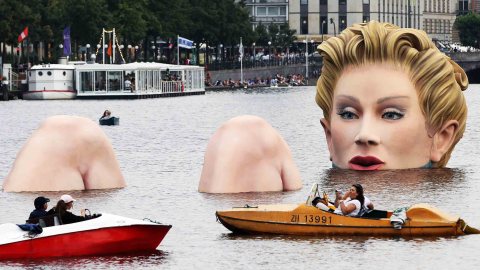Can We Learn to Be More Comfortable in Our Bodies?

Nestled against Cleveland National Forest sits Glen Ivy Hot Springs, a seventy-mile trip from Los Angeles. Every few months I drive down the 91 to the desert town of Corona to unwind in sulfur baths and saline pools. It is not an inexpensive entry—$46 on weekdays, $64 on weekends—but given the numerous pools and expansive grounds, it is well worth it.
It’s a little luxury for recharging, yet it’s sad that it should seem so. Public baths are ancient and historically reasonably priced. As Jamie Mackay writes on Aeon, bathing has been a “collective act” pervasive across cultures and time. I’ve visited sulfur baths and hammams throughout Morocco, sweat lodges and steam rooms in the Mexican mountains, and spent two days wading and sweating at the famed Széchenyi Thermal Bath in Budapest. I seek water wherever I go.
While Széchenyi is a bit of a grand affair, Moulay Yacoub Thermal Station, located twenty kilometers outside of Fes, is anything but. Built into a mountainside, the retreat is inexpensive and low-key—forget massages, the fire hose washing is sublime. While upscale spas line the tourist region of Casablanca, you can find hammams deep inside the city for three dollars, including a full argan oil treatment, which is much more representative of the bathhouses of old.
If I want to stay in Los Angeles, my choices are limited and pricey. Most are day spas, upselling services to the point where attending just to take the waters seems useless. The unkempt City Spa & Health Center gets you to 200 degrees in the Russian Rock Room, but getting whacked with oak twigs sets you back thirty bucks.
Mackay speculates on why this capitalistic drive should be so. Communal bathing is rare in a world where the ritual of the bathhouse is gone, replaced by a private cleaning regimen performed as quickly as possible. Taking a step back to seek broader implications, he continues:
The eclipse of communal bathing is one symptom of a wider global transformation, away from small ritualistic societies to vast urban metropolises populated by loose networks of private individuals.
Mackay invokes the sociological term “urban alienation,” captured perfectly by Eleanor Rigby in 1966—all the lonely people, where do they all come from? Such a rare historical occurrence could only happen in the modern metropolis, where no one knows your name.
Mackay notes the stark difference in various cultural takes on baths. The Moroccan hammam is a much different experience than the West Hollywood spa I occasionally visit if I’m craving a cold plunge. What unites public bathers worldwide is a sense of community:
What links all these examples, however, is the role such spaces have in bringing together people who might otherwise remain separate, and placing them in a situation of direct physical contact.
Disembodiment is common in a world that’s offloading memory to smart phones and freaking out over the cut (or not-so-cut, as the current contention goes) of bikinis. Mackay discusses the Japanese hadaka no tsukiai, ‘naked association,’ which reminds me of my favorite Bay Area bathhouse.
Archimedes Banya is on the edge of the slowly gentrifying Hunters Point neighborhood, just across the basin from the defunct Candlestick Park. You have two options: clothing or no. Being co-ed, it’s a rare example in America of being fully exposed to members of the opposite sex. And unlike much regarding sexuality in this country, there is little strangeness in disrobing around others. That is, there’s nothing sexual about it.
I learned this lesson nearly two decades ago on the beaches of Barcelona. America has a long and complicated history with the human body. It is treated as something both unabashedly celebrated and ceremoniously censored, often simultaneously. We worship the form while hating our own. In Spain bodies were just bodies, just as in France naked models grace magazine covers and bus stops with no problem.
While Mackay cites the even playing field of economic classes and conservation of energy resources, bodily comfort is perhaps the most relevant social matter of the bathhouse. Being around others in an intimate yet public setting goes a long way in helping dispel our odd reverence and disgust regarding biological realities. As is well known, suppression is the worst way of relating to others. Creating communal spaces where hygiene and honesty are openly explored is a powerful means of closing that emotional gap.
Mackay concludes,
There are pragmatic reasons to re-invent the practice, to be sure, but its anthropological diversity suggests that there might be a more fundamental need for this ancient and deeply human art.
To witness in real time digitally untouched bodies sounds basic, but in America we’re so unaccustomed to anything but perfectly staged selfies that a dose of reality is just what we need. When celebs post the occasional ‘no make-up’ shot we’re supposed to be impressed. More impressive would be turning down the noise of an unattainable perfection and just being ourselves around everyone else.
—
Derek Beres is working on his new book, Whole Motion: Training Your Brain and Body For Optimal Health (Carrel/Skyhorse, Spring 2017). He is based in Los Angeles. Stay in touch on Facebook and Twitter.





